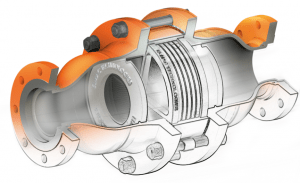What is a flame arrester?
By definition, a flame arrester is a passive device that allows gas to pass through it but stops the propagation of a flame.
But before we start to describe flamer arresters and how they work, it’s a good idea to start with a little background information. So let’s go back to how they first came to exist.
Flame arresters. From 1815 to today.
The first flame arrester was invented by Sir Humphrey Davy in 1815 to protect miners from explosions caused by using naked flames in mines. The Davy lamp housed a candle within a fine gauze mesh screen which allowed light to pass through it whilst preventing flames from ignited pockets of methane escaping from the lamp. The mesh acted as a heat sink; cooling the flame and preventing it from igniting gas on the outside of the lamp.
Things have moved on since then, of course. Today, Elmac is one of the UK’s leading companies in providing the safe installation, inspection and maintenance of flame arresters. And we’d be happy to show you how.
How combustion occurs
Now we know of the history, it’s good to know how combustion occurs and about explosion risks. Regardless of your industry, this could be vital information. So here’s a brief outline:
Combustion is the exothermic chemical reaction of a fuel in the presence of oxygen which results in the release of energy in the form of heat and light. The reaction zone between burnt and unburnt products is known as a flame.
In order for combustion to occur and a flame to be present, the reaction requires three elements: oxygen, ignition and fuel. When a flammable mixture is ignited the flame will propagate from the ignition source within the volume of the combustible fuel-air mix. Within pipeline systems this propagation is usually upstream (known as flashback) against the flow of gas.

Explosion risks
When it comes to navigating explosion risk factors, Elmac should be the first people you turn to. We’re experts at helping companies work out the risk factors involved: the likelihood of an explosive atmosphere will occur, and the potential for ignition.
The type of questions we use to assess the risk include:
- Are flammable gases/vapours present?
- Can dispersion of the fuel in air create an explosive atmosphere?
- Where can these explosive atmospheres occur?
- Is the potential for creation of an explosive atmosphere reliably prevented?
- Are the areas in which these explosive atmospheres present controlled?
- Is the potential ignition controlled?
In many cases it is not possible to avoid the potential for a gas/vapour explosion so its mitigation must then be considered. And the answer is invariably: flame arresters.
What are the different type of flame arresters?
Most flame arresters fall into two major categories:
- End of line, vent to atmosphere arresters – to prevent an atmospheric fire or explosion from entering an enclosure.
- In-Line – to prevent the propagation of an explosion within a pipeline.
Therefore, the main types of flame arresters Elmac supply, to all kinds of industrial businesses across the world, are: end-of-line deflagration, in-line deflagration and in-line detonation.
And to put your mind at rest, all our flame arresters meet current ATEX and ISO legislation and standards.
Flame arresters: element design
To go into more detail, the flame arrester element is made up of a matrix of channels the walls of which quench the flame as it passes through by removing heat energy from the reaction. (The quenching mechanism of MESG is the principal on which flame arrester elements are designed.)
Basically, flame arrester elements are made up from a matrix of channels. The height and length of these channels is tuned offering the least resistance to gas flow whilst still quenching a flame.
There are a variety of element designs available in the market today with the most common being crimped ribbon. The main thing to remember is that the quench gap of an element will be different to the MESG of the explosion group it is certified for.
If you’d like us to explain any of this further, please contact us to find out more. Or if you’d like to carry on reading, please see our guide to deflagration and detonation flame arresters.
